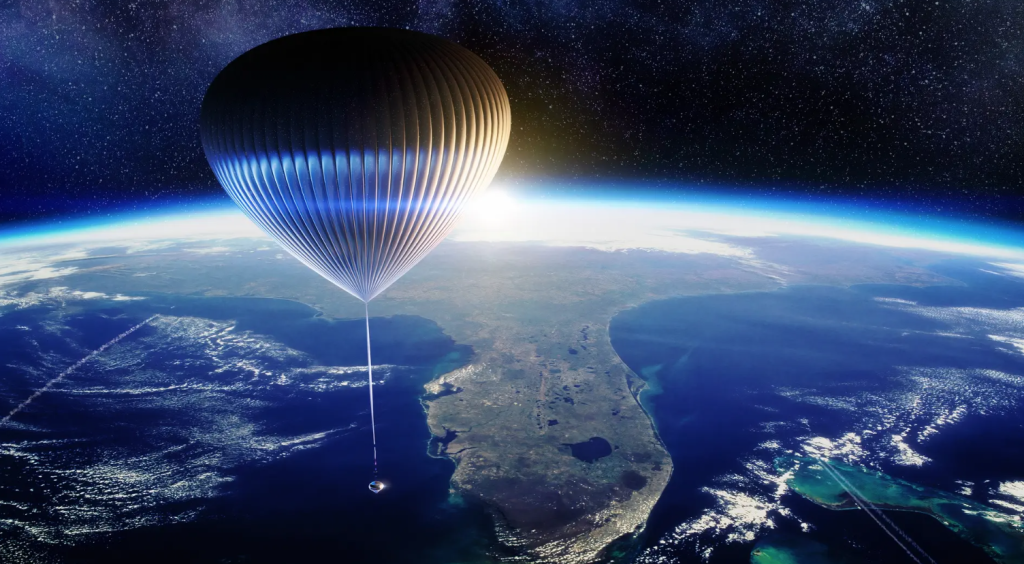The Space Neptune project received $40 million in funding
(Sustainabilityenvironment.com) – A few more months and anyone, with a reasonable budget, can fly into space aboard the first carbon-neutral spacecraft, Space Neptune.
The project was born from Space Perspective, a company that has many previous space missions in collaboration with NASA and beyond. The incredible project raised $40 million to fund the company through the start of commercial operations. The fund for Space Perspective comes from the Series A round, led by Prime Movers Lab, a “deep technology” venture capital fund. Several existing investors joined the round, along with new investors LightShed Ventures, a consumer and media VC fund, and Explorer 1 Fund, a new commercial space VC fund.
More than 30 km from the Earth’s surface
The ship is composed of three main members: SpaceBalloon, the capsule Neptune and the system Reserve Descent.
The maximum carbon-neutral efficiency takes place inside the gigantic space balloon powered by renewable hydrogen, abandoning the classic polluting and dangerous rockets. A proven technology already in use in the missions of Space Perspective with NASA is usually used to put in orbit research telescopes or heavy and fragile instruments.
With an average ascent of 12 miles per hour, the SpaceBalloon brings the Space Neptune capsule about 30 km from the surface of the Planet. Well above the 10 km to which the planes have accustomed us. From here you can admire the curvature of the Earth. A total flight of six hours, two of which in orbit above Earth.
A major difference of this spacecraft is that unlike usual, the crew capsule never separates from the take-off system. Space Neptune remains attached to SpaceBalloon for the entire flight, returning to the ground as she left.
The capsule Neptune
The spaceship of SpacePerspective was designed to be the most sustainable, accessible and safe on Earth, or rather above Earth. The pressurized capsule is spacious and equipped with every comfort, from wi-fi to champagne.
Nine reclining seats for 8 passengers and one pilot, freely reconfigurable to accommodate special events.
Read also Liquid hydrogen planes? From 2035 they will be reality
To admire the majestic panorama just look out of one of the gigantic windows, among the most degrees ever flown in space, with a 360# view. Let’s forget the narrow spaces of the spaceships known until now: in the capsule you can stand and walk freely around the “room”.
The Reserve Descent System
For maximum passenger safety, Neptune is also equipped with a backup descent system, the Reserve Descent. Four parachutes placed between the capsule and the SpaceBalloon, allow a safe landing, already tested for over a thousand flights over decades and with a success rate of 100%.
High ideals to protect our base spaceship: Earth
The founders of SpacePerspective took part in the research project Biosphere 2, a hermetic research environment created to test the potential of life on other planets. Hence the desire to share with the world the love for space. Because the more people will have the chance to admire our home, the Earth, from space, the greater will be the awareness of having to protect it. The journey is already carbon neutral, using hydrogen, a lighter gas than air, to go up and down in a controlled manner.
The construction of the SpaceBalloon and the Neptune capsule also meets sustainability criteria. The polyethylene that makes up the flask is recycled at the end of each flight. The interiors of the same capsule are built with this same recycled polyethylene.
“We’re passionate about fundamentally changing the way people access space both to perform much-needed research to benefit life on Earth and to affect how we view and connect with our planet. Today, it is more crucial than ever to see Earth as an interconnected planet, a spaceship for all humanity and our global biosphere. This expanded view of our world is the life-transforming perspective astronauts speak of when they see Earth in space. This is the space perspective”, concludes Jane Poynter, Founder and co-ceo.

